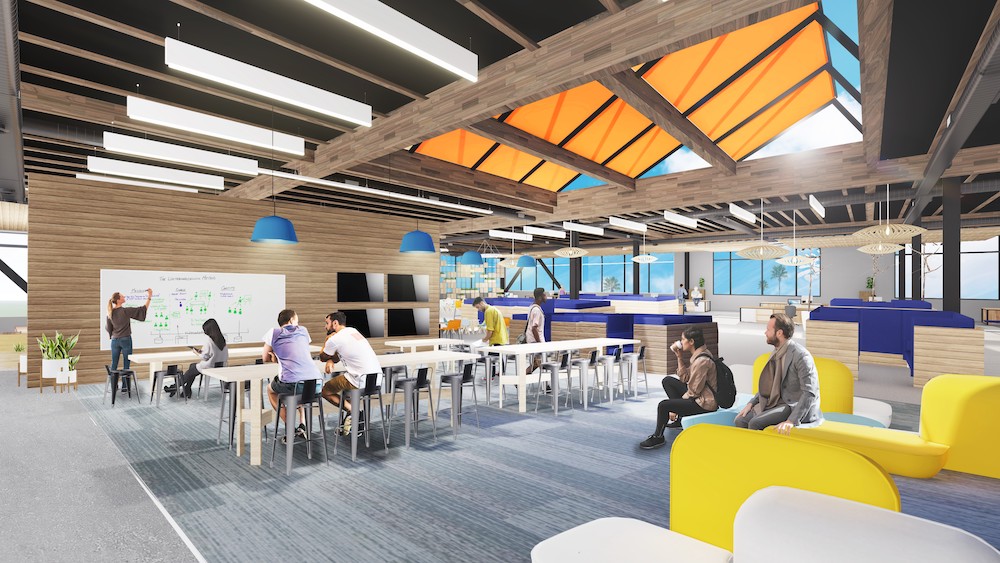Brendan Farrell and Ruba Younan of AO reflect on the new changes and trends they are seeing in post-pandemic office design.

The pandemic has taught us many things and has undeniably reshaped how we behave and interact. It made some people enjoy the solitude that comes from being distant while others grew to dread it.
It has also made us reflect on human connections and the value of time. While there were newfound hours added to the day from eliminated commutes, we also worked longer hours from home. Lacking the critical separation between “work” and “home” resulted in blurred boundaries between the two. It had many people struck with cabin fever and eager to come back to a physical office, or something resembling one.
…An engaging office work environment will always be a big part of what draws employees in…
As an architecture and design firm, we experienced the post-pandemic effects on the work environment and subsequently gained good understanding of the changes that are yet to come.
The pandemic spurred introspection and reflection on the value of the spaces that we inhabit and the desire to spend time in a comfortable environment, hence the boom we witnessed in home improvement that took place during that time. Conversely, an engaging office work environment will always be a big part of what draws employees in and gives them a place they enjoy coming back to, repeatedly. Company culture is more than free coffee and snacks. It’s the personal interactions and bonds between employees, employers and clients. While the pandemic’s resulting work-from-home model showed us that we can efficiently work remotely, it also highlighted the value of a well-designed office for collaboration, team building, innovation and group problem solving.

Inside Out
A major change we are seeing in post-pandemic office design is an increase in the use of exterior areas like balconies, rooftops and courtyards, either through the modification of existing space or the creation of new ones. Al fresco collaborative environments provide health benefits to employees by providing fresh air, sunshine, and ample buffer zones for the close-contact averse.
A new project in Southern California features outdoor area that takes center stage as a collaboration hub that spans the office, the cafeteria, and the team building functions. These exterior spaces work best in milder climates but can still succeed in other parts of the country when purposefully outfitted with appropriate solutions (folding doors, windows, screens, canopies, etc.) that can accommodate different seasons. This trend is especially popular with a younger generation of employees who are already comfortable with a nomadic work lifestyle after years of using the Wi-Fi at their local coffee shop or college campus.

Mixing It Up
If the new paradigm in workplace culture taught us anything, it’s that office spaces must have a soul. The collaborative workspaces of the future need to be inviting, familiar, and have a personality of their own. This principle was achieved at the recently completed mixed-use campus at Mountain View Village in Riverton, UT. The development includes extensive indoor and outdoor areas combining retail, dining, entertainment, and office space with a Main Street vibe. Known as Building M, the mixed-use office component features 137,000 square feet of creative office above 47,000 square feet of ground floor retail and is a great example of new construction with an inviting character. Employees here don’t just “go to work” but also enjoy a vibrant walkable community throughout their day, grabbing a bite at one of the many eateries, spending time outdoors in the central greenspace, or taking in a movie after work.
Another trend of note, which frankly should always have been a priority, is workspace design that has a focus on health and wellbeing. It’s reflected in the careful attention given to environmental elements like lighting, materials, ergonomics, biophilia and air treatment. While costs come into play on many of these decisions, happy and healthy employees are an amazing return on investment.

Stay Flexible
These past two years have been an outlier when it comes to client and employee relationships. In-person ways of meeting and communicating were jettisoned but we’ve adapted to a new situation by being flexible. And embracing flexibility will be the key to success going forward. It’s what clients crave when meeting with them on a project, and what pushes us to stretch our creativity, increasing the possibilities for innovation.
…Embracing flexibility will be the key to success going forward.
Employees crave flexibility, too – in their hours, their required face time, and in their workspaces. The pandemic pushed many companies to fast-track remote work plans. Those changes brought about more ideas that we are still exploring. The tools we implemented during COVID are still relevant today and continue to evolve, allowing us to build resiliency and confidence to take on whatever disruptions may come down the line.
We rely greatly on support staff and resources like IT, HR and Facilities teams to empower work and owe these departments a huge debt of gratitude. Where we are now, leading with the concept of flexibility and involving stakeholders at all levels in the conversation, is discerning the appropriate arrangement to accomplish business objectives, design innovation, and goals of contributing to a balanced lifestyle for employees.

